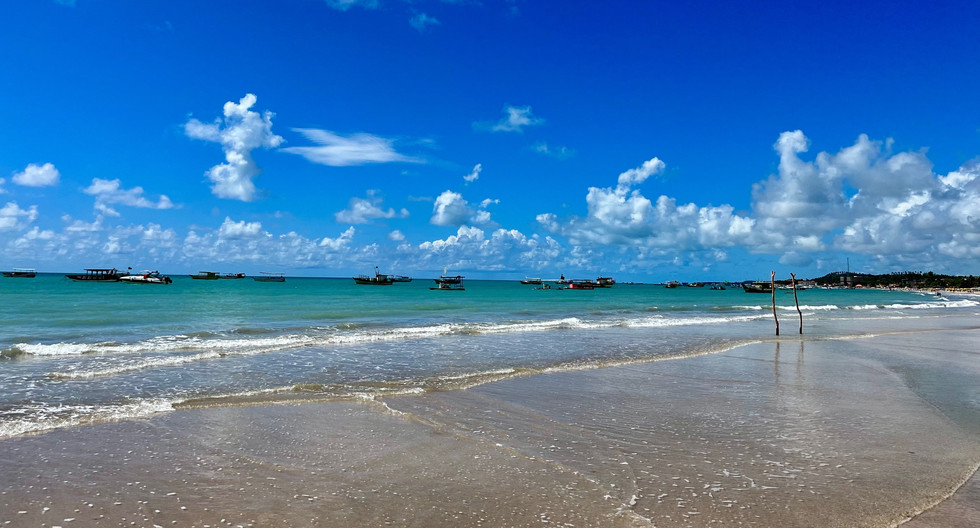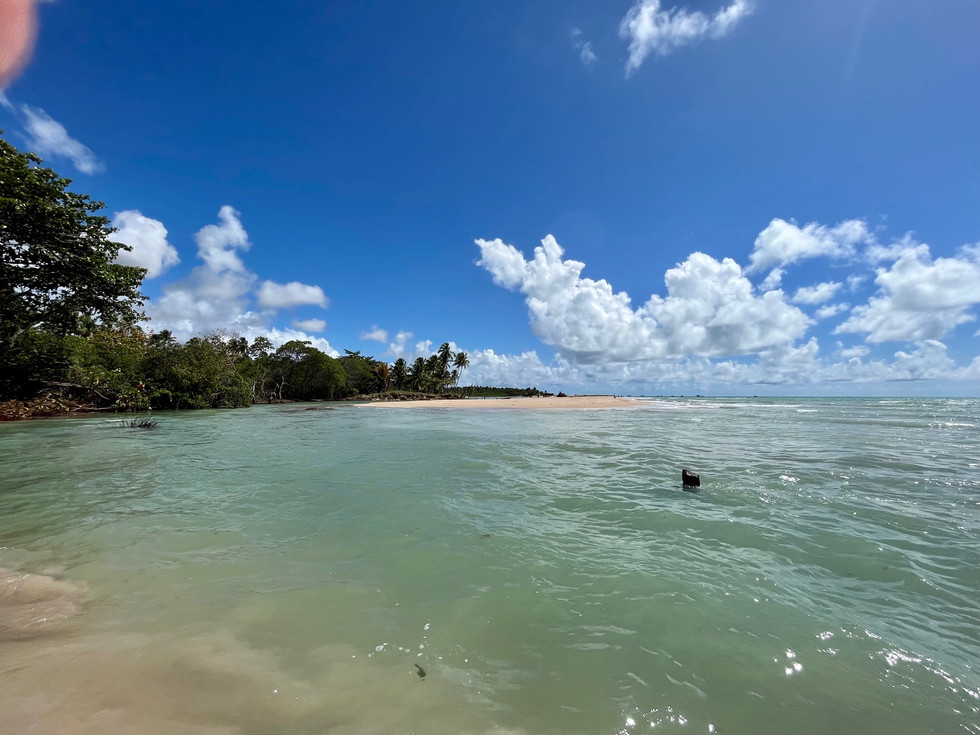Sailing South, down the Brazilian coast Recife to Salvador
- Ana

- Mar 5, 2023
- 6 min read
After enjoying a weekend in Recife, sorting out SIM cards and completing our check-in formalities (Fernando de Noronha does not have Receita Federal services), it was time to head towards Salvador, where we would try and fix our autopilot.
With a Brazilian "pilot book" (a pdf circulated by local sailors written by a local sailor) in hand, we tried to understand where we could stop along this 400 nautical miles leg of our journey.
To our surprise, there were very few places!
Between a study of the charts in more detail and the information available on these Brazilian notes there were a few river entrances that we could potentially enter if all the right conditions were present (little wind and swell, high tide and a Pilot boat that could guide us in at the simple price of 200R$ in and then again on the way out) and a couple of anchorages we could venture with the guidance of the charts (that seem to be somehow only slightly accurate or detailed unless there is a commercial harbour nearby) and satellite images that show the reefs. The same strategy of charts and satellite images would not be sufficient for crossing sandbars due to their constant movement.
With these places marked on the Brazilian "Pilot book" notes we tried to establish a route that would allow us to break the trip in shorter sails, or at least that was what we had hoped for.
To depart Recife we needed first to be able to exit Cabanga Iate Clube, which is reasonably shallow inside and with an entry channel that we can only navigate at high tide. Unfortunately, on Tuesday, the first high tide was quite early in the morning, before the marineros started working, which meant we needed to wait for the afternoon tide quite close to sundown. This meant we would have to anchor on the shoulder of the river in a very tight area due to the construction of a new marina right on the curve of the river for the night.

Early morning we lifted anchor and headed out of the Recife River and out into open water before the day traffic started

It was a very light sail marked by the many cargo vessels, pilot and tug boats we had to avoid both under power and at anchor.
The area south of Recife has a very big commercial port area with constant movement.
We arrived at our first stop Tamandaré mid-afternoon with a good tide. The wind and sea state were quite calm, allowing us to easily confirm the position of the reef and the passage that would allow us to anchor close to shore, protected from the ocean swell despite the channel markers indicated on the charts being nowhere to be seen.

(something we would find is quite common on the Brazilian coast except if there is a commercial harbour - then the charts are accurate, and the channel markers do exist)
The approach was easy, and in no time we were anchored behind the local day tripper boats on mooring balls. We had a very quiet night after a few refreshing swims off the back of The Dream.
We were still adjusting to the temperatures of 30 degrees night and day.
The following morning, an early rise waited for us to ensure we passed the reef at slack high tide. Our next planned stop was just a few hours away, the day was going to be of little to no wind, but we were expecting to have slightly unsettled weather in the coming days and preferred to be in a bigger anchorage where we had room to drop as much chain as we thought we could need.
We motor sailed for a few hours, quite close to shore appreciating the views. Barely any houses by the beachfront.
Quite a few jungle fires could be seen during our journey, quite sad to see big portions of forest being cleared in the distance.
From what we could tell from the Brazilian “pilot book” this place offered us a couple of options for where to stay once we passed the reef. This particular reef was quite long and with a few gaps marked on the chart and mentioned in the “pilot book”, again the channel markers were nowhere to be seen. One of the reef entrances was quite wide and deep as per the charts, and once we were reasonably close to it we could see our way in.
As we were making our approach a fishing vessel passed across our bow at good speed passing over the reef! He knew his way in at high tide.
The entrance channel was much deeper than we expected considering the tide range, and once inside, the entire area was also deeper than marked on the charts. We had set our minds to anchor near the Maragogi town in an area that has a double reef line with hopes of getting a bit more protection from any nastiness the forecast we were seeking protection from brought.
To our surprise, the depths of 8 metres extended at least 1 mile from the area we should have already run aground according to the charts!

A bit scary, this level of error on the charts, but we checked the area around us, and indeed the charts were very inaccurate, we could have possibly gone further in, but we felt that spot was good enough. We also kept a very good distance to the beach (roughly halfway between the beach and the inner reef) because it looked a bit Favela-style (slum).

Maragogi is a local beach destination it seems, and it boosts with tourists, lots of day tripper boats take people to go swim between the two lines of reefs and to a stretch of sand that at low tide allows for them to “beach” the day tripper boats and have huge parties.
By the second day, we became part of the tours with the tourist boats taking a detour on their route to pass close to us. After all, we were the only sailboat in the area, bigger than most they had ever seen, and we had a dog that swims on board. They were happy as Larry to glimpse Ella swimming.
We, on the other hand, were more interested in seeing exactly where were they crossing the inner reef to go snorkelling.
At the next low tide, we too went out for a snorkel in the reef, quite a nice few hours spent seeing the little colourful fishes.
Then the weather we were expecting came, a few thunderstorms passed north and south of our anchorage, and a big front that brought winds of nearly 35 knots and waves over the reef (it was high tide) eventually passed too. The anchorage got a little chop but nothing that made us worry, any weather front we experienced while sailing in the Mediterranean had created worst conditions. As the storm passed it left us with a few rainbows seen quite close to the boat.

On our third day, things got a bit weird.
We went for a walk on the beaches, and then when we returned to The Dream we decided to take Ella for a dinghy ride at high speed just like she enjoys. We were just doing a huge circle around the boat when we saw a day tripper boat approach our boat a bit without care grabbing the stanchions at the beam, and a guy trying to climb in (what stupidity, the swim platform was open they could have simply stepped in) we turned our dinghy fast and sped back to our boat with me screaming all sorts of inappropriate things in Portuguese to the people on the day-tripper boat. The driver panicked and apologised saying they were just wanting to take photos. Indeed they looked like the tourists on other boats but still a very strange situation. I threatened to call the Federal Police, and the guy just turned around and sped his little speed boat as fast as he could to the reef where all the other tourist boats were.
We took note of the boat name and registration number just in case.
This of course changed our mood, and the fun ended there and then. We packed everything and got ready to depart the following morning at first light, no more swims on the reef for us.
Given the conditions weren’t quite right to try and enter the two river entrances further down the coast that were noted as interesting but difficult, we decided to go all the way to Salvador nonstop, enduring many squalls and avoiding many more with the help of the radar.
A difficult two days and a bit of passage, where we spent most of the time either sweating crazy due to the high hot humidity or wet crazy due to the squalls of wind and rain.
We started our approach to Salvador and the Baia de Todos os Santos early morning.
In no time we were anchored by the entrance of Bahia Marina in front of the little beach. It was time to sleep and try drying out the cockpit.
***In the spirit of sharing our dreams and experiences we have shared this blog post in the NOFOREIGNLAND.COM website sailors community.
























Comments